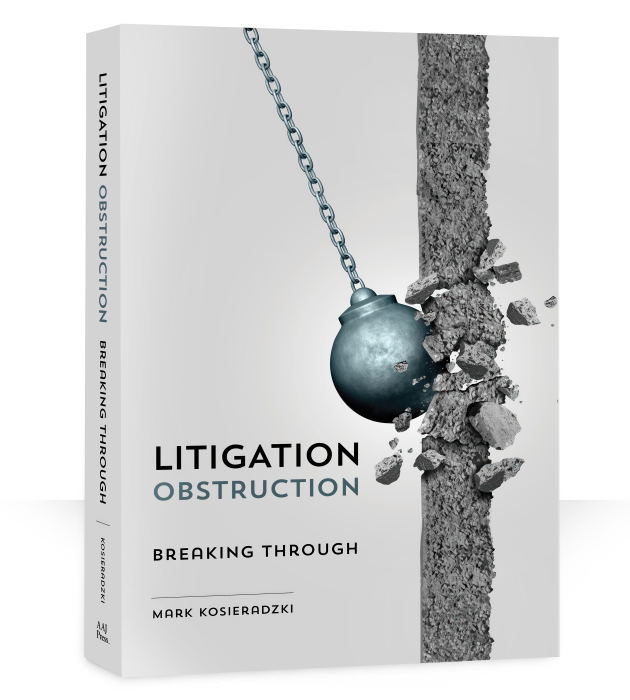AAJ Press

Litigation Obstruction: Breaking Through
The rules of discovery recognize that some litigants may want to hide the truth. To evade accountability. To win at all costs. When understood, the rules enable you to cut through the nonsense, get to the truth, and hold obstructionists personally responsible. This book will arm practicing attorneys with the rules and case law that govern written discovery, the tools to manage ubiquitous obstruction tactics, the power to hold obstructionists accountable, and the skills to marshal the evidence necessary to win at trial.

Mark R. Kosieradzki
Mark R. Kosieradzki is known as one of the country’s leading authorities on litigation and depositions technique, strategy, and law. Author of 30(b)(6): Deposing Corporations, Organizations & the Government 2nd ed. and Deposition Obstruction: Breaking Through, he’s been featured on CNN for his work on sexual abuse in nursing homes. The Minneapolis Star Tribune describes him as “one of the nation’s most feared elder abuse litigators.”
Table of Contents
Introduction
Chapter 1: Purpose of the Rules of Civil Procedure
- The Purpose of the Discovery Rules
- Discovery Is Interpreted Liberally
- Conclusion
Chapter 2: Litigation Ethics
- Introduction
- Preamble to the Model Rules: Zealous Advocacy
- Model Rule 1.1: Competent Representation
- Model Rule 1.3: Diligence
- Model Rule 3.2: Expediting Litigation
- Model Rule 3.3: Candor Toward the Tribunal
- Model Rule 3.4: Fairness to Opposing Party and Counsel
- Evasive Discovery Responses
- Witness Tampering
- Model Rule 4.2: Communication with Witnesses
- Involuntary Representation
- Model Rule 4.1: Truthfulness in Statements to Others
- Model Rule 8.4: Misconduct
- Model Rule 5.1: Managing Attorneys and Partners
- Summary
3: Scope of Discovery
- Introduction
- Scope of Discovery
- Relevance
- Claims and Defenses
- Privilege
- Proportionality
- Summary
Chapter 4: Attorney's Discovery Rules
- Introduction
- Attorney Certification of Disclosures, Requests, and Responses
- Rule 26 (g): The Signature Requirement
- Initial Disclosures Certification
- Discovery Request Certification
- Discovery Response Certification
- Discovery Objection Certification
- Unsigned Disclosures, Responses, Requests, and Objections
- Mandatory Sanctions for Improper Certification
- Summary
Chapter 5: Discovery Request and Response Rules
- Introduction
- Starting Discovery
- Discovery Responses Must Be Responsive, Complete, and Un-Evasive
- Supplementation
- Supplementation Must Be Timely
- Supplementation After Discovery Closes
- Supplementing Expert Witness Reports
- Summary
Chapter 6: Boilerplate Objections
- Introduction
- Attorney's Duty: Only Valid Objections
- Proper Objections Must Be Supported
- Reserved/Preamble Blanket Objections
- Boilerplate Objections
- Conditional Responses with Objections
- Summary
Chapter 7: Objection Requirements
- Introduction
- Specificity
- Object and Answer in Part
- Grounds for Objection
- Relevance
- Vague
- Overbroad
- Proportionality
- Privilege
- Summary
Chapter 8: Interrogatories
- Introduction
- Interrogatories: Rule 33
- Scope of Interrogatory Questions
- Limitation: 25 Discrete Separate Subject
- Interrogatories
- Interrogatory Response Requirements
- Objections
- Interrogatories Must Be Signed
- Summary
Chapter 9: Requests for Production
- Introduction
- Requests for Production: Rule 34
- Designated Information: “Reasonable Particularity”
- Responses to Requests for Production
- Timing of Production
- Objections to Production
- Unilateral Redactions
- Available From Other Sources
- Qualified Response
- Manner of Production: The Usual Course of Business
- Signature Requirement
- Possession, Custody, or Control
- Electronically Stored Information (ESI)
- Form of ESI Request
- ESI Request Response
- Summary
Chapter 10: Requests for Admissions
- Introduction
- Admissions: Rule 36
- Application of Law to Fact
- Crafting the Request
- Responding to the Request
- Signature Requirements
- Challenging the Response to the Request for Admissions
- Summary
Chapter 11: Contention Discovery
- Introduction
- Rule 8: The General Rules of Pleading
- Rule 8: The General Rules of Pleading
- Contention Discovery
- Contention Interrogatories
- Contention Admissions
- Contention Depositions
- Contention Response Timing
- Summary
Chapter 12: Motion for Protective Order
- Introduction
- Rule 26(c): Protective Orders
- A Party’s Burden to Show Good Cause
- Timeliness—When to Bring a Motion for Protection
- Conferral
- Summary
Chapter 13: Demand for Stipulated Confidentiality
- Introduction
- Stipulated Particularized Confidentiality Agreements
- Umbrella Confidentiality Orders
- Umbrella Orders Require Good Cause
- Stipulated Blanket, or Umbrella, Confidentiality Agreements
- The Problem with Umbrella Confidentiality Orders
- Challenging Demands for Blanket or Umbrella
- Confidentiality Orders
- Alternative: Temporary Confidentiality Agreement
- Summary
Chapter 14: Challenging Obstructive Tactics
- Introduction
- Motion to Compel Complete Initial Disclosures
- Motion to Compel Complete Discovery Responses
- Duty to Timely Challenge
- Determining Timeliness
- Motions to Compel Brought Before the Close of Discovery
- Motions to Compel That Would Necessitate Extending Discovery
- Meet and Confer Requirements
- Burden
- Summary
Chapter 15: Pre-Empting Objections with Rule 30(b)(6)
- Introduction
- Neutralize Objections Before They Are Made
- Rule 30(b)(6) Depositions by Designation
- Foundational Rule 30(b)(6) Deposition
- The Foundational Rule 30(b)(6) Deposition Notice
- Taking a Foundational Rule 30(b)(6) Deposition
- What Documents Exist?
- What Is the Purpose of the Document?
- How Do the Documents Reach Intended Users?
- Document Retention and Destruction Policies
- Where are the Documents Located?
- Summary
Chapter 16: Managing the Obstruction
- Introduction
- Treating Discovery Obstruction as a Logistics Problem
- The Importance of a Tracking System for Requests and Objections
- Tracking Requests and Objections
- Effectively Using a Spreadsheet to Manage the Logistics of Obstructive Objections
- Managing the Meet and Confer Requirement
- Tracking the Communications
- Motions to Compel
- Summary
Chapter 17: Sanctions
- Introduction
- Attorney Improperly Certifies Response, Disclosure, or Objection: Rule 26(g)
- Mandatory and Appropriate Sanctions
- Sanction the Person or Entity Responsible
- Substantial Justification
- Attorney or Party Fails to Participate, in Good Faith, in Discovery Planning: Rule 37(f)
- Party Totally Fails to Appear, Answer, or Respond: Rule 37(d)
- Party Objects, or Responds or Answers Unsatisfactorily: Rule 37(a)
- Party Fails to Disclose or Fails to Supplement Disclosure or Answer: 37(c)(1)
- Failure to Comply with a Discovery Court Order: Rule 37(b)
- Appropriate Sanctions
- Party Fails to Admit Matters Later Proved True: Rule 37(c)(2)
- Party Fails to Preserve ESI: Rule 37(e)
- Egregious Misconduct by an Attorney or Party: The Inherent Power of the Court
- Entirely Without Color
- Bad Faith
- Attorney Intentionally Disregards Their Duties to the Court: 28 U.S.C. § 1927
- Summary
Epilogue
Appendix
- A - Federal Rules of Civil Procedure 1, 5, 5.2, 11, 16, 26(a)(1), 26(b)(1), 26(b)(5), 26(c), 26(d), 26(e), 26(f), 26(g), 30(b)(6), 33, 34, 36, 37, 28 U.S.C. § 1927
- B - Comparing Federal Rule 26(b)(1) to State Counterparts
- C - Comparing Federal Rule 26(g) to State Counterparts
- D - Comparing Federal Rule 34(b)(2)(C) Objection Disclosure Requirements to State Counterparts
- E - Rule 34: Comparing Definition of “Control” by Circuit
- F - Stipulation for ESI Search Protocol
- G - Rule 34 Request for Production Electronic Medical Record Audit Data
- H - Sample Request for Admission Document Authentication
- Federal Rule of Civil Procedure 36(a)(1)(B)
- I - Stipulated Particularized Confidentiality Agreement
- Conferral letter
- Agreement
- J - Umbrella Confidentiality Agreement
- K - Stipulated Temporary Confidentiality Agreement
- Conferral Letter
- Temporary Confidentiality Agreement
- L - Conferral Time Log
- M - Document/ESI Foundational 30(b)(6) Deposition Notice
- N - The Stonewall Solution Litigation Obstruction Management
- O - Challenging Obstruction: Conferral Letters, Motion, and Brief
- Conferment Letter 1, with Authority
- Conferment Letter 2, Scheduling
- Conferment Letter 3, Conferral Summary
- Notice of Motion
- Withdrawal of Objections
- Attorney Declaration
- Template Federal Brief
- Proposed Order
About the Author
Index

